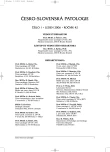Human Embryonal Tissues of all Three Germ Layers can Express the CD30 Antigen. An Immunohistochemical Study of 30 Fetuses Coming after Therapeutic Abortions from Week 8th to week 16th of Gestation
Lidské embryonální tkáně všech tří zárodečných listů mohou exprimovat CD30 antigen. Imunohistochemická studie 30 plodů z léčebných potratů v 8.–16. týdnu gestace
Exprese antigenu CO30 byla považována za typickou pro nádorové buňky Hodgkinovy nemoci a anaplastického velkobuněčného lymfomu. V reaktivní lymfatické tkáni je CD30 exprimován pouze aktivovanými lymfoblasty. V poslední době se však množí zprávy o expresi CD30 nelymfatickými tkáněmi a nádory, jako jsou embryonální karcinom, seminom, kultivované makrofágy, nádorové histiocty, buňky deciduy, a buňky mezoteliomu. Vzhledem ke skutečnosti, že CD30 může zprostředkovávat signály pro buněčnou proliferaci a apoptózu, sledovali jsme pomocí monoklonální protilátky Ber-H2 distribuci tohoto antigenu v archivních parafinových bločcích tkání všech tří zárodečných listů plodů stáří 8.–16. týdnu gestace.
CD30 je exprimován již v časném fetálním období (8.–10. týdnu) v nejrůznějších tkáních orgány, s výjimkou kůže a thymu, v nichž dochází k expresi později. To odpovídá skutečnosti, že tyto nejsou před 10., resp. 13. týdnem ještě diferencovány. V kardiovaskulárním a dýchacím systému jsme expresi neprokázali.
Závěr:
Průkaz exprese CD30 v období končící organogeneze, které je výrazně hormonálně závislé, ukazuje, že tento antigen hraje důležitou roli v buněčném vývoji, vyzrávání a přechodu k plné diferenciaci téměř všech fetálních tkání a struktur.
Klíčová slova:
CD30 antigen – fetální tkáně – 8.–16. týden gestace
Authors:
D. Tamiolakis 1; G. Maroulis 2; C. Simopoulos 3; D. Verettas 4; N. Papadopoulos 5; J. Venizelos 5; M. Lambropoulou 5; G. Koutsougeras 6; A. Karpouzis 7; C. Kouskoukis 7
Authors‘ workplace:
Department of Cytology, General Hospital of Chania, Crete
1; Department of Obstetrics and Gynecology, Democritus University of Thrace
2; Department of Experimental Surgery, Democritus University of Thrace
3; Department of Orthopedics, Democritus University of Thrace
4; Department of Histology - Embryology, Democritus University of Thrace
5; Department of Obstetrics and Gynecology, General Hospital of Alexandroupolis
6; Department of Dermatology, Democritus University of Thrace, Greece
7
Published in:
Čes.-slov. Patol., 42, 2006, No. 1, p. 9-15
Category:
Overview
Originally, expression of the CD30 antigen was shown to be typical of the tumor cells of Hodgkin disease and of anaplastic large cell lymphomas. In reactive lymphoid tissue, CD30 is expressed only in a small population of activated lymphoid blasts. Since then, several reports have been published describing CD30 expression in non lymphoid tissues and neoplasms, such as embryonal carcinomas, seminomas, cultivated macrophages, histiocytic neoplastic cells, deciduals cells, and mesothelioma cells. In order to gain insight into the functions of CD30, given that it can mediate signals for cell proliferation and apoptosis, we studied the distribution of the antigen in different fetal archival paraffin-embedded tissues from week 8th to 16th of gestation.
We investigated the immunohistochemical expression of CD30 in 30 paraffin-embedded tissue samples representing all three germ layers, using the monoclonal antibody Ber-H2
CD30 is expressed early in human fetal development (8th–10th week) in a wide variety of tissues, with the exception of the skin and thymus in which it is expressed later on. This is consistent with the observation that these organs are not fully differentiated before 10th and 13th week, respectively. No expression was observed in the cardiovascular and respiratory systems.
The finding of CD30 expression in the terminal period of organogenesis, period, which is highly hormone related, implies that the antigen has an important role in cell development, maturation, and pathway to terminal differentiation in almost all fetal tissues and structures.
Key words:
CD30 antigen – fetal tissues – 8th-16th week of gestation
Labels
Anatomical pathology Forensic medical examiner ToxicologyArticle was published in
Czecho-Slovak Pathology

2006 Issue 1
Most read in this issue
- Cervical Cancer Precursors: Cytohistologic Correlation with the Results of HPV Testing
- Pyloric Gland Adenoma – How to Diagnose?
- Isolated Lymphadenopathy as the First Presentation of Systemic Mastocytosis – Description of Two Cases
- Malignant Fibrous Histiocytoma of the Breast: Report of Two Cases
